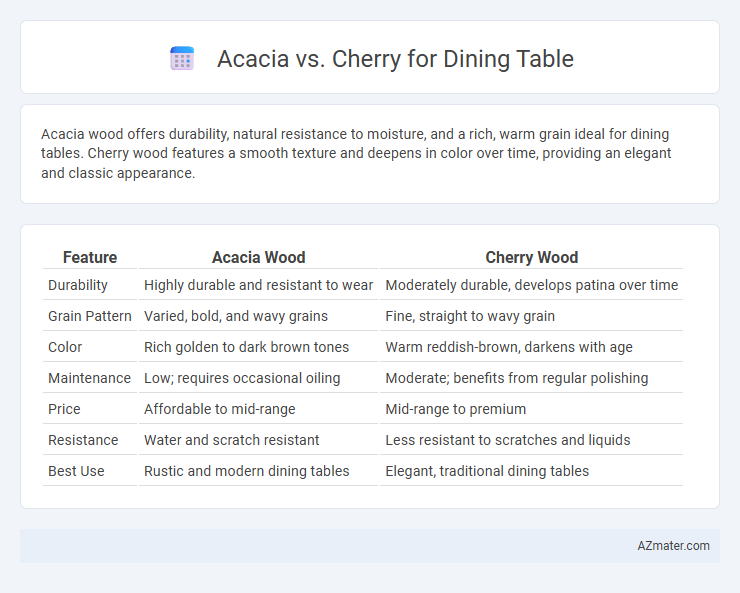Acacia wood offers durability, natural resistance to moisture, and a rich, warm grain ideal for dining tables. Cherry wood features a smooth texture and deepens in color over time, providing an elegant and classic appearance.
Table of Comparison
| Feature | Acacia Wood | Cherry Wood |
|---|---|---|
| Durability | Highly durable and resistant to wear | Moderately durable, develops patina over time |
| Grain Pattern | Varied, bold, and wavy grains | Fine, straight to wavy grain |
| Color | Rich golden to dark brown tones | Warm reddish-brown, darkens with age |
| Maintenance | Low; requires occasional oiling | Moderate; benefits from regular polishing |
| Price | Affordable to mid-range | Mid-range to premium |
| Resistance | Water and scratch resistant | Less resistant to scratches and liquids |
| Best Use | Rustic and modern dining tables | Elegant, traditional dining tables |
Acacia vs Cherry Dining Tables: An Introduction
Acacia dining tables offer exceptional durability and resistance to moisture, making them ideal for high-traffic dining areas. Cherry dining tables are prized for their rich, warm tones and smooth grain that deepen in color with age, enhancing their classic elegance. Both woods provide sturdy construction, but Acacia delivers a more rustic appeal while Cherry boasts timeless sophistication.
Origin and Growth Patterns of Acacia and Cherry Wood
Acacia wood originates primarily from Australia and Africa, known for its fast growth and dense, durable timber that thrives well in warm climates. Cherry wood, native to North America and parts of Europe, exhibits slower growth, resulting in a finer grain and rich, reddish-brown hue that deepens over time. Both woods offer unique textures and colors for dining tables, but Acacia's rapid growth makes it more sustainable, while Cherry's slower maturation process contributes to its prized aesthetic qualities.
Appearance and Color: Acacia Compared to Cherry
Acacia dining tables feature a rich, varied grain with warm golden to reddish-brown hues, offering a rustic and natural aesthetic. Cherry wood presents a smoother, finer grain with a rich, reddish tone that deepens to a darker mahogany over time, providing a classic and elegant look. The contrast in appearance between Acacia's bold patterns and Cherry's consistent, refined finish influences the dining table's style, from casual to formal settings.
Grain Patterns and Texture Differences
Acacia wood features a rich, varied grain pattern with swirling and contrasting streaks, offering a bold and rustic aesthetic ideal for dining tables. In contrast, cherry wood displays a smooth, fine grain with subtle, straight lines and a uniform texture that deepens in color over time, providing a classic and elegant look. The coarse, textured surface of acacia contrasts with cherry's satiny finish, influencing both visual appeal and tactile experience in dining furniture.
Durability and Hardness: Which Wood Lasts Longer?
Acacia wood is highly durable and resistant to moisture, making it an excellent choice for dining tables that endure daily use and spills, while Cherry wood, though slightly softer, offers a smooth finish and develops a rich patina over time. Acacia ranks higher on the Janka hardness scale, typically around 1,700, compared to Cherry's 950, indicating better resistance to dents and scratches. Due to its superior hardness and natural oils, Acacia generally lasts longer with less maintenance, whereas Cherry requires more care to maintain its elegant appearance.
Maintenance Needs: Caring for Acacia and Cherry Tables
Acacia dining tables require regular oiling to preserve their natural oils and prevent drying, while cherry tables benefit from occasional waxing to maintain their rich color and smooth finish. Both woods should be cleaned with a soft, damp cloth and mild soap, avoiding harsh chemicals that can damage the surface. Acacia is more resistant to scratches and moisture, but both wood types need protection from direct sunlight to prevent fading and warping.
Cost Comparison: Acacia vs Cherry Dining Tables
Acacia dining tables typically cost less than cherry dining tables due to Acacia's faster growth rate and greater availability, making it a more budget-friendly option. Cherry wood, valued for its rich color and fine grain, generally commands a higher price reflecting its premium quality and durability. Buyers seeking cost-effective yet durable furniture often choose Acacia, while those prioritizing classic aesthetics and long-term investment may prefer Cherry despite its higher cost.
Environmental Impact and Sustainability
Acacia wood, known for its rapid growth and renewable qualities, offers a more sustainable option for dining tables compared to cherry wood, which grows slowly and requires more time to mature. Acacia's dense grain and natural resistance to pests reduce the need for chemical treatments, enhancing its eco-friendliness, while cherry wood's harvesting can contribute to deforestation in certain regions. Choosing Acacia supports responsible forestry practices and a smaller carbon footprint, making it a preferable choice for environmentally conscious consumers.
Best Design Styles for Acacia and Cherry Dining Tables
Acacia dining tables are prized for their rich, varied grain and durability, complementing rustic, farmhouse, and industrial design styles with warm, natural tones and textured finishes. Cherry dining tables exhibit a smooth, fine grain with a reddish hue that deepens over time, making them ideal for traditional, classic, and mid-century modern interiors, where elegance and refined craftsmanship are highlighted. Both woods offer timeless appeal, but Acacia excels in casual, organic aesthetics, while Cherry enhances sophisticated, polished environments.
Choosing the Right Wood: Acacia or Cherry for Your Dining Room
Acacia wood offers durability, rich grain patterns, and resistance to water, making it ideal for busy dining rooms with a rustic or tropical aesthetic. Cherry wood provides a smooth, fine grain with a warm, reddish tone that deepens over time, perfect for formal or traditional dining spaces seeking elegance and timeless beauty. Choosing between Acacia and Cherry depends on prioritizing either sturdy, low-maintenance characteristics or classic, refined appearance combined with gradual patina development.

Infographic: Acacia vs Cherry for Dining Table
 azmater.com
azmater.com